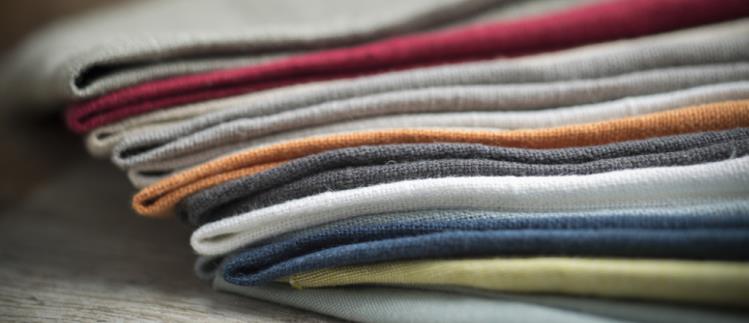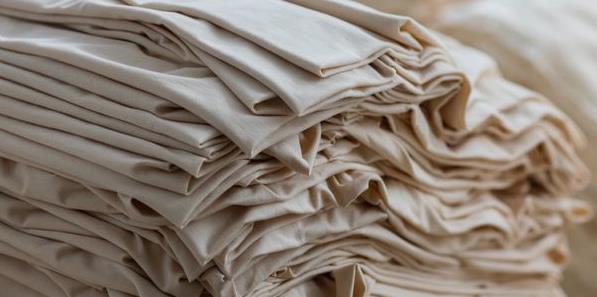Cotton fabric has been around for thousands of years. It has made its appearance throughout history and cultures, but is still being part of fashion innovations to this day!
What is cotton fabric exactly, and how has this common fabric been used throughout history and in modern times? In this article, I will run through some of the most interesting facts about cotton!
What is Cotton Fabric?

Cotton fabric is the most popular organic fabric being used worldwide. Its widespread availability and popularity are due to the various characteristics that make it an ideal material for a variety of industries and applications.
The cotton fiber itself is the seed-hair fiber of the genus Gossypium in the family Malvaceae. The actual cotton of the plant is the white, fluffy ball. It is composed of mostly cellulose, an organic compound found in most plants. The cotton is spun into threads and used in a variety of products, from apparel to industrial and agricultural purposes.
Its name has roots in the Arabic language. Its earliest known cotton samples were dated to 5500 BC at the Bolan Pass of Pakistan. Evidence of cotton textiles were found in sites of the Indus Valley Civilization. Since then, wild cotton has been domesticated, farmed, and produced worldwide – the biggest non-food agricultural industry in history.
How is Cotton Fabric Made?
According to Britannica, cotton fiber is processed through a series of steps before it can be produced into clothing.
Ginning or Ring Spinning
These two processes similarly remove foreign objects from the pure cotton.
Ginning is the mechanical process of removing the fibers from the cotton seeds. Ring spinning is a princess where the mass of cotton is opened, cleaned, and combed through in several ways to ensure that the cotton is free from contaminants.
Carding
The carding machine uses a brush mechanism to separate the single fibers into parallel arrangements. They are formed into a rope called card sliver.
Drawing
The card slivers are then rolled into uniform threads.
Roving
The sliver is made into roving through further pulling and slight twisting.
Spinning
Finally, the cotton threads a wound into bobbin form, and can be sold as is or further produced as full cotton fabrics.
What Different Types of Cotton Fabric Are There?
Since cotton is produced in various parts of the world, there is a good number of variations of cotton fabric available in the market. There are four main types of cotton which are most widely used:
- Upland cotton or Mexican cotton (Gossypium hirsutum)
- Tree cotton from India and Pakistan (Gossypium arboreum)
- Levant cotton from Sub-Saharan Africa and Arabia (Gossypium herbaceum)
- Pima cotton or extra-long-staple cotton from South America (Gossypium barbadense)
However, aside from these types of cotton, the selection of fabrics becomes even more complex. Some are specialized all-cotton fabrics, while others are a blend of cotton and another fiber. Here are some of the most well-known types:
- Brushed Cotton
- Canvas
- Chambray
- Chino
- Cotton Twill
- Cotton Lawn
- Denim
- Egyptian Cotton
- Jersey
- Muslin
- Poly Cotton
- Poplin
- Quilting Cotton
- Seersucker
- Voile
Today, researchers and scientists are still finding ways to perfect cotton and find new uses for the fabric through different innovations.
What are the Characteristics of Cotton?

Why does everyone love cotton, a fabric that is so common and casual, but so well respected?
Soft
Cotton is among the most comfortable fabrics available in the market. Spinning the fluffy fiber results in a gorgeous and soft interlinked fabric.
Breathable
The hollow fibers of cotton allow air to pass through cloth and cool our skin.
Durable
Cotton fibers are strong because of their microscopic links.
Customizable
Because cotton is so absorbent, the fibers can hold dye and other additives. It’s easy to create beautiful patterns on cotton, and scientists are experimenting with cotton that eliminates odor, repels flame, and so on.
How Do You Care for Cotton?
Cotton is simple and straightforward to care for, but extra steps must be taken to keep the fabric looking fresh after washing.
Check the Label
Read the label to find out if your garment is pre-shrunk and cold water only. Otherwise, you can use the washing machine and the dryer.
Machine Wash or Hand Wash
If your cotton is not pre-shrunk, wash it in cold water. Otherwise, you can use hot water.
Tumble Dry or Air Dry
It is safe to tumble dry cotton because of its durability while damp. However, natural air drying is always a nice choice if you have the time and the space.
How to Identify a Cotton Fabric
100% cotton is always desirable. Aside from checking the garment’s label, you can also determine a cotton fabric by inspecting how it feels – try not to use your hands, but rather rub in on another part like your cheek. Your sensitive skin will be able to tell cotton’s distinctly soft, smooth texture versus synthetic counterparts.
Where is Cotton Fabric Produced?
With the main types of cotton being grown in North, Central, and South America, as well as India, Pakistan, Arabia, and Africa, you can expect the industries to revolve around these territories. However, in terms of production, India holds the top spot in the world, followed by China and the US.
Why use Cotton Fabric?
What is the benefit of using cotton? Aside from its natural characteristics, it is also used for its other purposes. Since it is a natural fiber, organic cotton is sustainable, vegan, and hypoallergenic. It is also easy to wash and care for, with a little effort.
How is Cotton Made Into Fabric?

After harvesting cotton, it goes through several processes to become the cotton cloth we know. There are two main processes to make cotton fabric: the spinning stage, where the plant is carded, combed, drawn, spun and turned into usable uniform threads in bobbins. Then, the cotton threads are subject to the weaving process, where the warp and weft are arranged on a loom and woven together to form the final product.
What is Cotton Fabric Mainly Used For?
Cotton is so versatile that various industries have their uses for the wonder fabric. It’s most well known as a fabric for everyday clothes. However, it’s also a very popular fabric for home furnishings and is also used in more industrial requirements and products.
Is Cotton Easy to Clean?
Cotton is easy to clean as it doesn’t require too many steps to deal with. However, since it’s a highly absorbent cloth, you might want to watch out for stains. While light staining will be easy to wash out, deeper stains and permanent colorings will take extra effort to wash out.
Why is Cotton so Comfortable?
The softness of cotton clothing is due to the nature of the cotton fiber itself. Outside of the seed, it is a ball of fluff that is not only soft but hollow – allowing air to pass through easily. Not only is the surface of the cotton clothing soft and smooth, but feels cool on the skin, too.
Is Cotton Breathable?
The fibers of cotton are naturally hollow. This allows it to be light, airy, and cool. It also has an absorbent property that allows sweat on the body to dissipate quickly. That is why cotton clothing is so popular in countries with warmer climates and during the summertime.
Does Cotton Shrink in the Wash?
Organic cloth is affected by washing methods to a certain degree, usually 2-5%. This is typically only on its first wash. Further shrinkage happens with poor care of your cotton clothing.
A lot of cotton apparel is actually available pre-shrunk before purchase so that consumers would not be surprised with the sudden first-wash shrinkage.
Can you Iron Cotton?
Ironing is ideal for smoothing out your cotton apparel. You just need to take care of the cotton during the process.
Iron the item on the reverse side of the finish. Lightly mist it with water, so that the wrinkles are softer and easier to iron. Use high heat.
Is Cotton Fabric Strong?
One of cotton’s best characteristics is its durability. They are known to hold up for years with due care. This is because individual cotton fibers are really strong – especially when they are wet. The fiber cells consist of strong interlinking layers that hold up against friction, abrasion, and weather conditions.
How Does Cotton Fabric Impact the Environment?
Cotton itself is an organic, renewable resource that can be considered environmentally friendly.
However, the culprit is the production process of cotton. According to the WWF, worldwide cotton production contributes to water wastage and contamination, soil erosion, and pollution. Due to the size of the industry, its effects are enormous and unsustainable.
Conclusion
It is estimated that half of the apparel around the world is made with cotton. This enduring fabric will continue to be one of the most useful and popular in the world, and it’s made only more exciting due to the innovations that are being made by scientists and designers.
